Articles and Features
Top 10 Kinetic Art Artists and Pioneers

Kinetic art has a fascination with motion which potentially can encompass a wide spectrum of modern and contemporary art from Impressionism onwards. In presenting works of art which move, moving art, or give the impression of movement—from mobiles to mechanised sculptures to Op art paintings which contain optical defects or illusions that seem to rotate or vibrate in front of the eyes—Kinetic artists offered us some of the most quintessential expressions of modern art’s key intersections with the technological facets of the modern age itself. The Kinetic art movement offered the revolutionary notion of works of art which extended in time as well as space, where viewing and perception were also contingent on the unfolding of motion or an action over time or within a cycle. Some Kinetic artists presented works which relied on mechanised movement, some focused on the conflation of mechanisation with science as it could be represented or depicted within an art object, some felt that art could represent the machine and its utopian possibilities for integration into modern daily life, whilst others were interested in analogies between machines and human bodies.
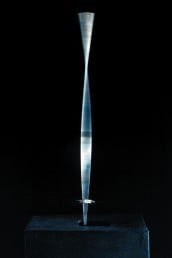
1. Naum Gabo
In the period after the First World War, Gabo and his brother, fellow artist Antoine Pevsner, were inspired to move back to Russia from Europe by the events of the Revolution and the fertile culture it provided for a new approach to art making. As a young man in post-Revolutionary Russia, Gabo was closely associated with Constructivism and Suprematism, elements of which sought to blur the boundaries between creative and functional processes. He incorporated principles from engineering and architecture into his creative explorations, and used his sculptures to describe and demonstrate new concepts of science, technology, engineering and architecture such as Einstein’s space-time relativity. Like all artists of the Marxist lineage Gabo believed that art should have an explicit and functional value in society. he demonstrated cutting-edge techniques and construction methods in his work, and even designed complex architectural schema. As a sculptor, one of Gabo’s most important discoveries was that empty space could be used as a key compositional constituent of sculpture. Constructing his sculptures from sets of interlocking components, rather than carving or moulding them from blocks of inert materials, allowed him to incorporate space in his work more readily, where void and form were enabled to complement each other in new ways. By incorporating moving parts into his sculpture, or static elements which strongly implied movement, Gabo’s work stands at the forefront of a whole artistic tradition, emblematic of the kind of technological progress we associate with the twentieth century, Kinetic Art. His Kinetic Construction of 1920, constructed of metal and wood with an electric motor, is often considered the first work of Kinetic Art.
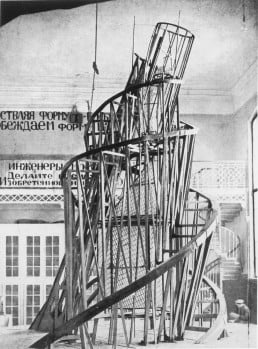
2. Vladimir Tatlin
Vladimir Tatlin was a central figure in the birth of Russian Constructivism. Combining lessons from Picasso’s Analytic and Synthetic Cubism and from different strands of Futurism, he created objects that spanned both sculpture and architecture. Initially trained in the traditional manner as a painter of icons, he soon abandoned the traditionally pictorial concerns of painting and instead concentrated on the possibilities inherent in the materials he used – often metal, glass, and wood. Above all he wanted to apply art to societal concerns and the rhetoric of the new post-revolutionary state. He is best remembered for his Monument to the Third International (1919-20), conceived as a design for the Communist International headquarters. It was elaborated into a large model rendering but never actually became a built edifice. This project crystallised his desire to bring about a synthesis of art and technology, and has remained a key monument of that utopian goal for generations of artists since, whilst his career generally has come to embody that spirit of twentieth century avant-gardism that endeavoured to make art serve everyday life. Tatlin’s ‘Monument’ was his great contribution to Lenin’s plan for “Monumental Propaganda”, a campaign to replace Tsarist figurative sculptures in Russain public spaces with new projects commemorating the heroes of the Revolution and its abstract ideals. Believing that a new culture should have a new art to represent it Tatlin proposed that his tower would be constructed of iron and glass, would reach a height of 1,300 feet and would even straddle the river in Petrograd (St. Petersburg). Not only would the Tower function as a commemorative monument, but would also be a headquarters for the various functions of the Communist party with internal volumes designed to revolve at different speeds.

© Calder Foundation
3. Alexander Calder
Alexander Calder was an American sculptor who is best known for his innovative mobiles that embrace chance in their aesthetic and his monumental public sculptures. Born into a family of artists, Calder’s work first gained attention in Paris in the 1920s and was soon championed by the Museum of Modern Art in New York. One of the towering figures of twentieth century modernism, Calder was a key figure in the introduction of movement into works of art. He began this innovation by making wire sculptures of figurines. Instead of making drawings on the page, he made drawings of figures in space. Many artists made contour line drawings on paper, but Calder was the first to use wire to create three-dimensional line “drawings” of people, animals, and objects. These “linear sculptures” introduced line into sculpture as an element unto itself, the malleable outlines of which seemed to provide animating qualities to the figures themselves. In the next stage of his evolution Calder shifted from figurative linear sculptures in wire to abstract forms in motion by creating the first mobiles. Composed of lengths of wire, pivoted on central frames of skeletal support wires and counterbalanced along their lengths and at their ends with thin metal plates, discs and fins, the appearance of the entire piece was randomly arranged and changed compositional appearance constantly simply because the constituents moved in relation to each other. During the course of his long career the scale and ambition of these mobile sculptures was breathtakingly augmented to include massive constructions of seemingly weightless grace.
4. Victor Vasarely
A Hungarian-French painter and sculptor, Vasarely was preoccupied with the various effects movement in art could create and convey for his entire working life. In Paris in the 1930s and 1940s he worked as a commercial graphic designer, eventually developing a career as a fine artist known for striking geometric compositions that shimmer and pulsate. As a student of Constructivism, Vasarely believed that art should have a functional purpose within society, an aim he pursued partly by exploring the overlaps between art and architecture. As well as designing murals and other site specific projects specifically for architectural spaces, Vasarely believed that his visual vocabulary of interchangeable compositional elements could be used in urban planning, as a way of combining qualities of uniformity, repetition and modularity. His works combined virtuous technical skills with meticulous precision, combining an engineer’s sense of materials with a highly sophisticated scientific understanding of optical effects. He is best known for his grid-like paintings and sculptures of the 1960s onwards, which play with the reader’s sense of visual form by creating illusory effects of spatial depth, perspective, and motion. His works undertook to make the act of looking one of the key subjects of his work, exploring the differences between what the eye is able to see and what is actually there. In doing this Vasarely was perhaps the only kinetic art who realised that Kinetic art did not actually have to have physically moving components in order to elicit compelling sensations of movement. Whilst he did make constructivist type sculptural reliefs with moving parts, his renown resides more in his extraordinary series of paintings and sculptures which used geometrical effects to suggest motion within static forms. Employing visual tricks in a similar vein to Escher, Vasarely made abstract works that oscillate and vibrate, and created illusions of concave or convex actual space from the flat planar surface of the painting. Vasarely’s pioneering techniques not only influenced the Op Art movement of the 1960s, but also contributed to the aesthetic that came to be associated with psychedelia.
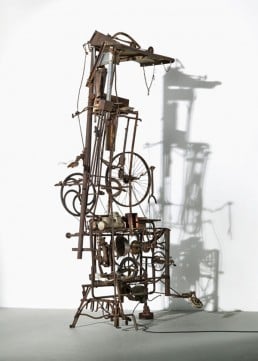
5. Jean Tinguely
Swiss artist Jean Tinguely first began creating assemblages composed of found-objects, largely updating the dadaist practice of creating sculptural works from oddments of ephemera and found-objects— in his case most often scrap metal that might easily have been considered junk. Tinguely was intrigued by the prevailing debate regarding the effect of mechanisation on modern society, and the manner that industrial innovation had impacted society. Altering his practice to incorporate motors and machinery he activated his previously static works, a facet of his work that would become the leitmotif of his entire artistic career. Considered one of the most prominent practitioners of kinetic art, Tingeuly’s works satirised industrialisation and modern society’s increased reliance on technology and machines. Tinguely used the term “Metamechanics” to describe how he set his assemblage sculptures into motion with some form of motor or system of mechanics. A archetypal Tinguely work incorporates found objects of the type elevated to artistic status by the Dada artists by whom he was influenced, machine components and then various forms of mechanised linkages between them. The idea to put assemblages such as this into movement was significant as it evoked an interactive relationship between the spectator and the object, where the artwork unfolded over time with a strongly performative element. The viewer’s experience was liberated from looking at a static composition from a single vantage point, but instead consisted of viewing the sculpture in the round and thus from multiple perspectives each of which differed from the last, according to the multiple moving elements in each part of the whole. What interested him most was how machines work, how they move, the noises they make and the intrinsic poetry of their rhythms.

Courtesy George Rickey Estate and Marlborough Gallery.
6. George Rickey
George Rickey was an American sculptor whose Kinetic Art works used simple armatures of steel, that moved and pivoted in often counter intuitive ways. “The object was for the pieces to perform as they could, and I wanted their movement to be slow, unhampered, deliberate—but at the same time unpredictable,” Rickey once explained. “As for shape, I wanted only the most ordinary shapes—simple, hackneyed, geometrical. I wanted whatever eloquence there was to come out of the performance of the piece—never out of the shape itself.” Growing up as a child in South Bend, Indiana, he was fascinated by a particular kind of window lock common to buildings of the area. Their means of latching included a kind of counter-clockwise conical hinge. Despite beginning as a painter, while serving in World War II for the United States, Rickey worked as a gunnery mechanic in the airforce. This time spent working with machinery revived his childhood interest, and the exposure to mechanical systems, high-quality ball bearings, balancing weights, riveted sheet metal, and lightweight aircraft construction techniques were to become the foundation for most of his forays into lightweight, delicately balanced, wind-activated kinetic sculpture, in which the axes of motion give unexpected movement to the rectilinear fixed forms of the works.
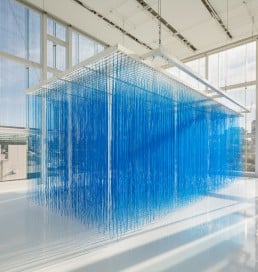
7. Jesús Rafael Soto
Villareal is an American artist whose work combines LED lights, often in enormous quantities, with encoded computer programming to create illuminated displays. The work is premised on stripping systems down to their essence, often in a reductive way to focus on lowest common denominators such as pixels or the zeros and ones in binary code. As Villareal builds and layers the arrangement of LEDS, he programs them to move, change, interact and ultimately grow into complex organisms that are inspired by mathematician John Conway’s work with cellular automata and the Game of Life. Thus his work explores not only the physical but adds the dimension of time combining both spatial and temporal resolution. Central to his work is the element of chance. The artist’s goal is to create a rich environment in which emergent behavior can occur without a preconceived outcome. He is an active participant in the process through the careful selection of compelling sequences. These selections are then further refined and layered through simple operations such as addition, subtraction and multiplication. Parameters like opacity, speed and scale are also manipulated through the artist’s custom software, creating compositions that are displayed in random order and for a random amount of time. Ultimately, the visual manifestation of code in light is at the core of Villareal’s interest.

Courtesy the artist and Walker Art Center
8. Rebecca Horn
Since the beginning of the 1970s, Rebecca Horn has created a highly diverse body of work including conceptually based, process-oriented, prosthetic performances, numerous films, feathery and kinetic metal sculptures, vast installations, loose drawings, self-documentary performance photographs, and painting machines. Her work often literally or metaphorically inhibits or extends the (usually female) body into space. Frequently, component parts of her art can serve as mechanical replacements for the body suggestive of works that have a life of their own, autonomous from either a body or a controlling force. Horn’s oeuvre is rich in art-historical connotation while being bound together by a consistent, thematic logic that often includes references to mythical, historical, literary, and spiritual imagery. In her first performances, known as ‘body-extensions’ she utilised her own form to express and explore the body in space, looking for a kind of equilibrium between the two. Later in the 1970s she began to use machines as surrogate for the human form—kinetic sculptures which became ever more elaborate. The objects used and specially made for these installations have included violins, suitcases, batons, ladders, pianos, feather fans, metronomes, small metal hammers, black water basins, spiral drawing machines and huge funnels.

9. Christian Moeller
Christian Moeller is a sculptor and installation artist, and the current professor and Chair of the Department of Design Media Arts at University of California, Los Angeles UCLA. He was born in Frankfurt, Germany where he lived and worked until moving to the United States in 2001. His interactive work has been shown at museums, galleries and art festivals internationally, but his renown is founded upon more recent works which can be seen as urban scale objects and monumental installations in public spaces. Moeller first gained widespread recognition working with electronic media technologies to produce innovative and intense physical events. His installations employed a variety of technological media, ranging from handheld objects to architectural scale installations. Many of his works throughout the 1990s sought to explore the overlap and synergies between architecture, sound, technology, and moving images. A pioneer in this field, his work over the past two decades has been increasingly focused on the field of public art where he usually works with metal or composites. Many of his works have become iconic local landmarks.
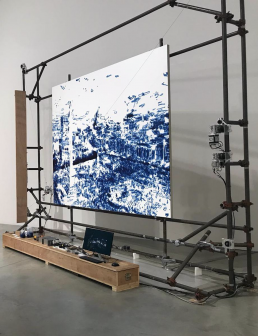
Image courtesy the artist and Lisson Gallery
10. Liu Xiaodong
Liu Xiaodong is one of China’s pre-eminent contemporary artists, and has developed his renown primarily as a painter. His masterly and often large-scale paintings depict scenes of quotidian modern life around the globe. He has gained international fame for his ability to depict moments and stories from contemporary human life as well as situations and landscapes with outstanding immediacy and extraordinary empathy. He was trained in both the classical Chinese tradition and the official Chinese variant of Soviet Social Realism, employed in Communist political systems most often to glorify the ethos of the State and the dignity of the workers within it. In recent years Liu has departed from working exclusively on the traditional idiom oil painting, instead developing a technologically radical project to create 21st-century landscape paintings using robotic arms and surveillance cameras. The works consist of a live feed from a given location, streaming data and imagery from that location feeding a painting machine to both process and transcribe the ever-changing flow of visual information from the live situation into a complex network of abstract marks on canvas – resulting in a machine-manufactured painting created during, and as part of, the exhibition. The robotic brush is held aloft by a network of wires that pull and push the pigment across the surface, dependent on the images being fed through the computers and screens stationed below. Far from a jerky, machinic gesture, Liu has sought to imbue a painterly sensibility in his digital surrogate, albeit one he has no further control over apart from choosing the location and paint colour. So far the painting machine has been trained on intersections and busy byways, capturing vehicles, pedestrians and changing weather conditions in cities such as Beijing, Shanghai, Jincheng, Gwangju, Berlin, Karlsruhe, Sydney and London. The painting machine is a dispassionate and tireless producer, mechanically completing the artist’s bidding, day and night, resulting in a futuristic vision of a time when artificial intelligence and automated computer-learning has the potential likelihood to overtake time-consuming labour.